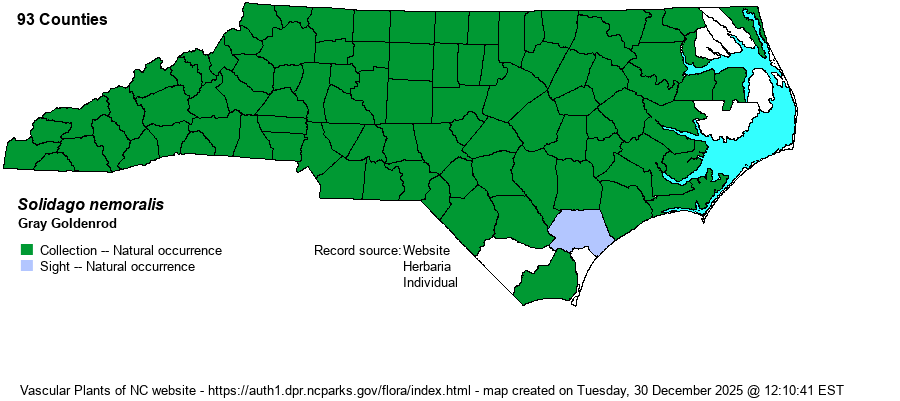| Author | Aiton | |
| Distribution | Throughout the state, but apparently absent from some tidewater counties.
N.S. to ND, south to FL and TX. | |
| Abundance | Common to abundant across the Piedmont and Coastal Plain, except scarce to absent in the far northeastern counties, and uncommon in the far southern counties. Fairly common to common in the Mountains. This is one of the state's most numerous goldenrods. | |
| Habitat | Dry open woodlands and edges, glades, barrens, roadsides and banks, fields, pastures, clearings, powerlines. | |
| Phenology | Flowering and fruiting July-October. | |
| Identification | Gray Goldenrod gets its name from the whitish, very short hairs that cover stems and leaves, giving the plant a grayish-green or pale green color as opposed to bright or dark green color. Stems typically grow only to 1-2 feet tall, erect to more often leaning, and with a terminal, triangular-shaped inflorescence of short to longish branches. Basal and lower leaves have elliptical blades with blunt teeth and are long-tapered to the petiole; middle to upper stem leaves are lance-shaped and have fascicles of tiny leaves in each axil. The ray florets are long for a goldenrod. S. puberula is similar, but almost always is erect and its leaves are glabrous beneath except for the midrib (vs. short-pubescent). Also that species has a rather cylindrical/tubular inflorescence and not triangular-shaped. Gray Goldenrod is easily and quickly encountered on most late summer and fall walks along powerlines and brushy wooded borders. | |
| Taxonomic Comments | Weakley (2024) does not include varieties now.
| |
| Other Common Name(s) | Old-field Goldenrod, Field Goldenrod | |
| State Rank | S5 | |
| Global Rank | G5 | |
| State Status | | |
| US Status | | |
| USACE-agcp | | |
| USACE-emp | | |

